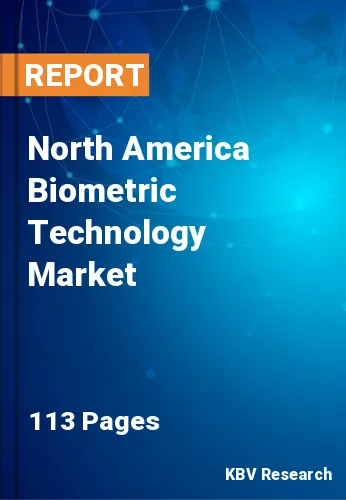The North America Biometric Technology Market would witness market growth of 12.5% CAGR during the forecast period (2021-2027).
Biometrics technology reduces fraud and security breaches when compared to traditional approaches such as the usage of tokens and passwords. A biometrics system compares fingerprints or other recordable parts like the iris or the face using a reader, accompanying software, and a database, resulting in high accuracy and security. Moreover, increased usage of the technology in the e-commerce industry for safe payments is likely to propel the market further upwards during the forecast period.
During the forecast period, growing concerns about internal and external securities are likely to push the market. Additionally, rising usage of technology for employee authentication and attendance in the public and private sectors is expected to increase overall demand in the coming years. Furthermore, the increased implementation of biometrics systems in the BFSI sector for safeguarding financial transactions around the studied regions will bolster the market even more. In addition, the widespread use of advanced authentication and identification systems in smartphones and tablets is driving the demand for biometrics technology
Contact-less biometrics systems are widely being adopted in military and government applications, which is driving sales in North America. The deployment of biometric technology with face recognition, fingerprint, and iris scanning for border security by the El Paso Police Department in the United States, for example, is accelerating market expansion. The nVIAsoft Corporation, HID Global, and M2SYS Technology are among the leading market participants in the United States. Furthermore, being near to end users allows technology companies to gather regular feedback from them in order to enhance their products. The financial services industry is a hotbed of biometric authentication activities. Wells Fargo, Bank of America, Citibank, Mastercard, and other financial institutions in the region use a variety of technologies to authenticate their clients at ATMs, online, and at the point of sale, ranging from fingerprint readers to heartbeat-monitoring bracelets. An expanding availability of biometrics-enabled personal devices, such as Apple and Samsung's fingerprint scanning smartphones, is a major contributor to mobile biometrics growth.
The US market dominated the North America Biometric Technology Market by Country 2020, and would continue to be a dominant market till 2027; thereby, achieving a market value of $20,652.4 million by 2027. The Canada market is poised to grow at a CAGR of 15.1% during (2021 - 2027). Additionally, The Mexico market would exhibit a CAGR of 14.1% during (2021 - 2027).
Based on Type, the market is segmented into Physiological Biometrics and Behavioral Biometrics. Based on Physiological Biometrics Type, the market is segmented into Face Recognition, Fingerprint Recognition, Iris Recognition, Hand Geometry, and Others. Based on Behavioral Biometrics Type, the market is segmented into Signature Recognition, Voice Recognition, and Others. Based on Component, the market is segmented into Hardware and Software. Based on End User, the market is segmented into Public Sector, BFSI, Healthcare, IT & Telecom, and Others. Based on countries, the market is segmented into U.S., Mexico, Canada, and Rest of North America.
Free Valuable Insights: The Global Biometric Technology Market is Estimated to reach $85 Billion by 2027, at a CAGR of 14.1%
The market research report covers the analysis of key stake holders of the market. Key companies profiled in the report include NEC Corporation, Thales Group S.A., Fujitsu Limited, ImageWare Systems, Inc., Precise Biometrics AB, BIO-key International, Inc., Secunet Security Networks AG, Suprema, Inc., IDEMIA SAS, and HID Global Corporation.
By Type
By Component
By End User
By Country
Our team of dedicated experts can provide you with attractive expansion opportunities for your business.

